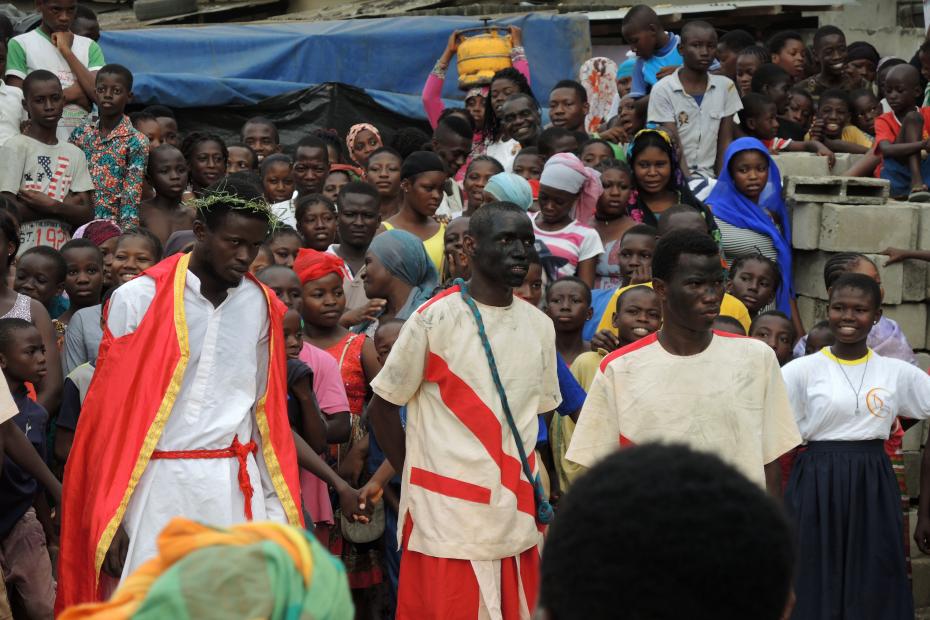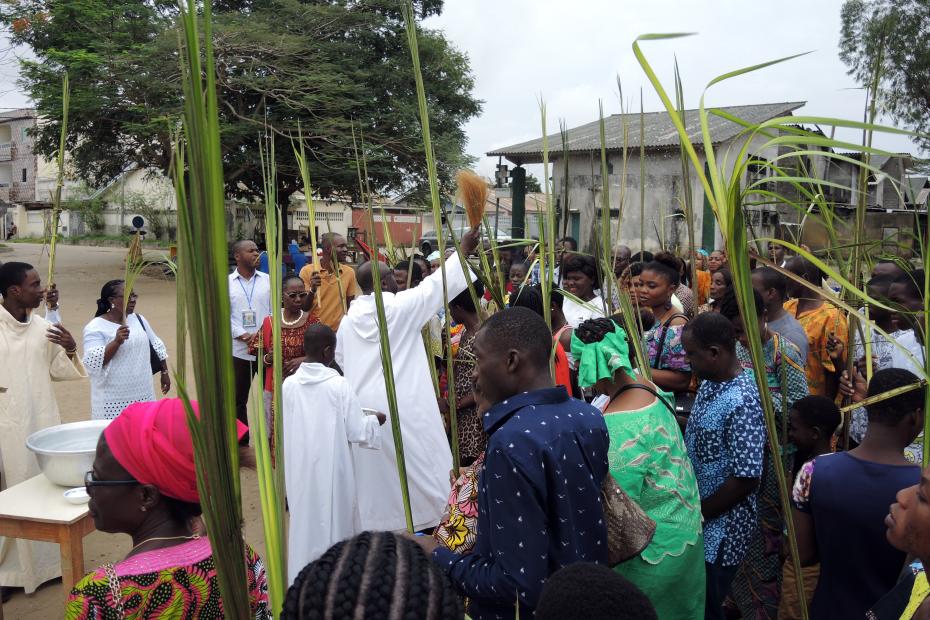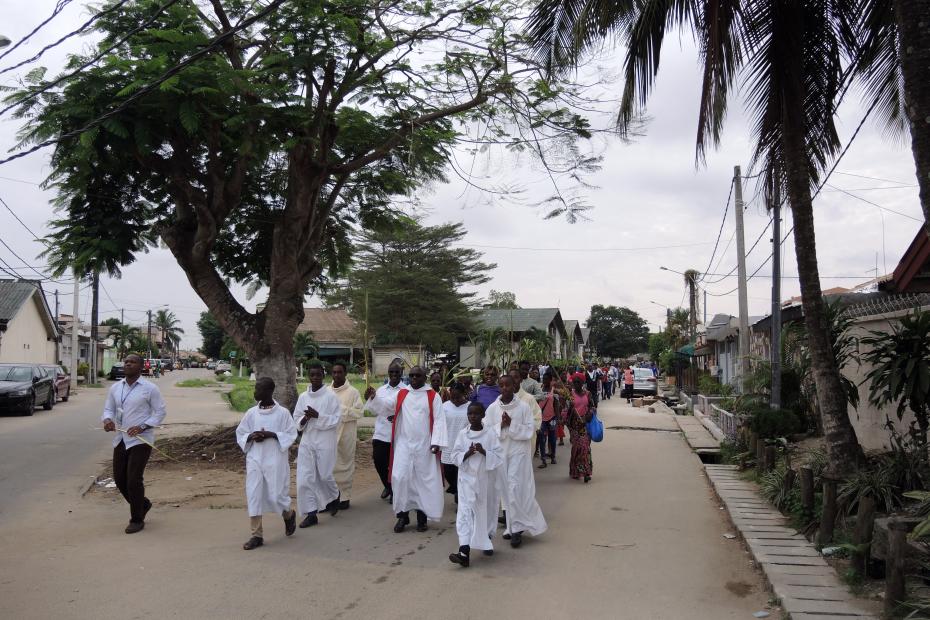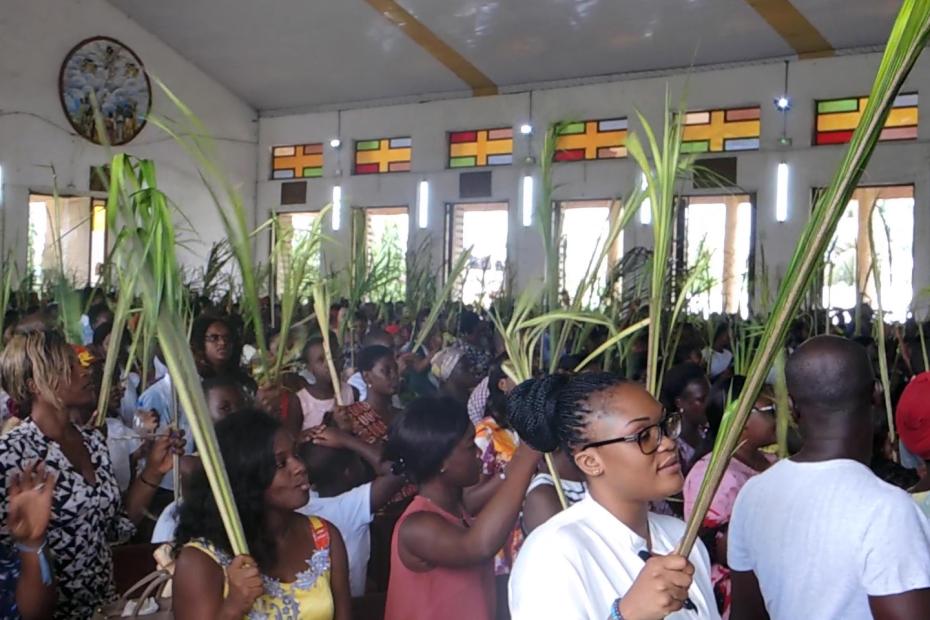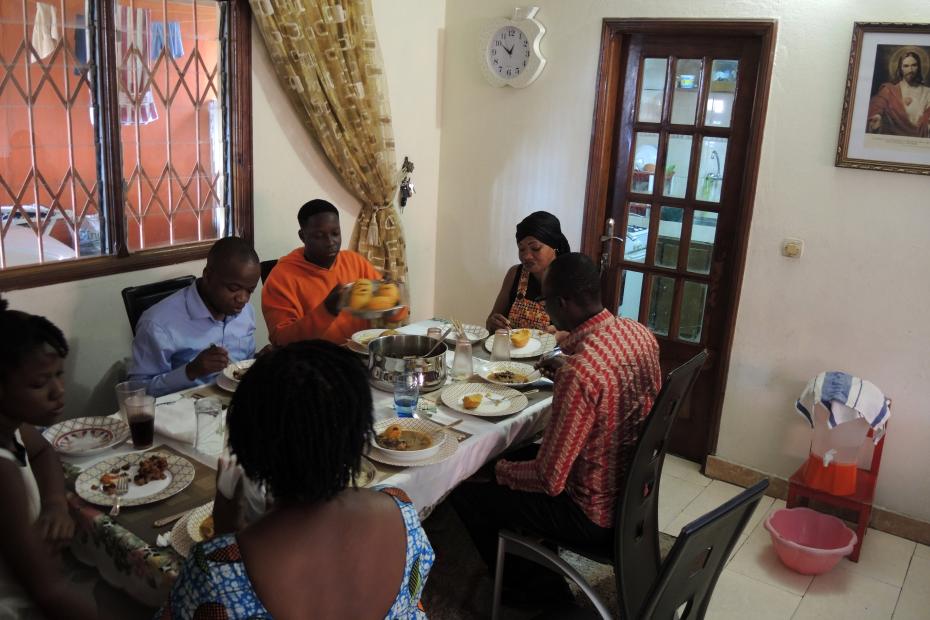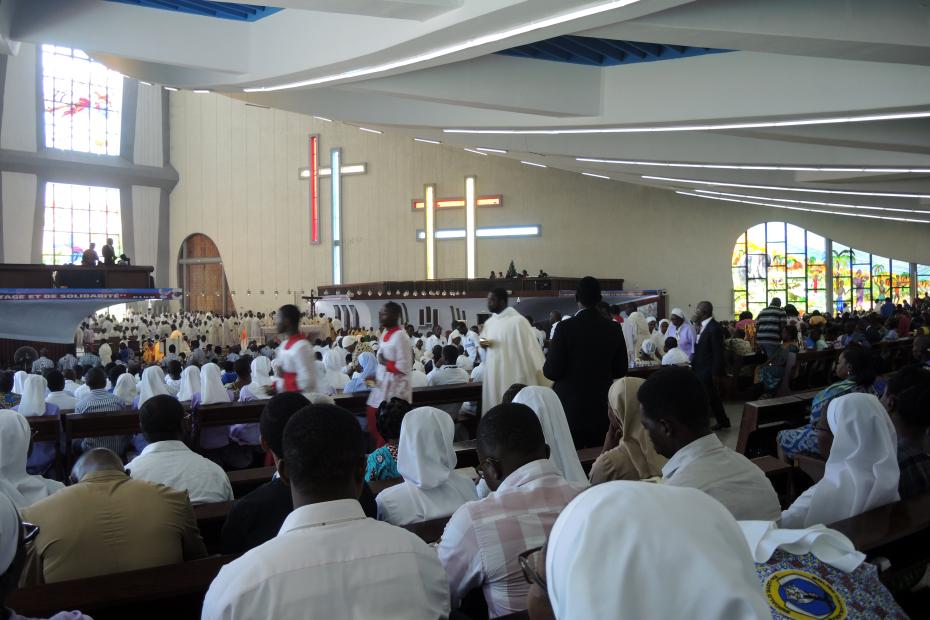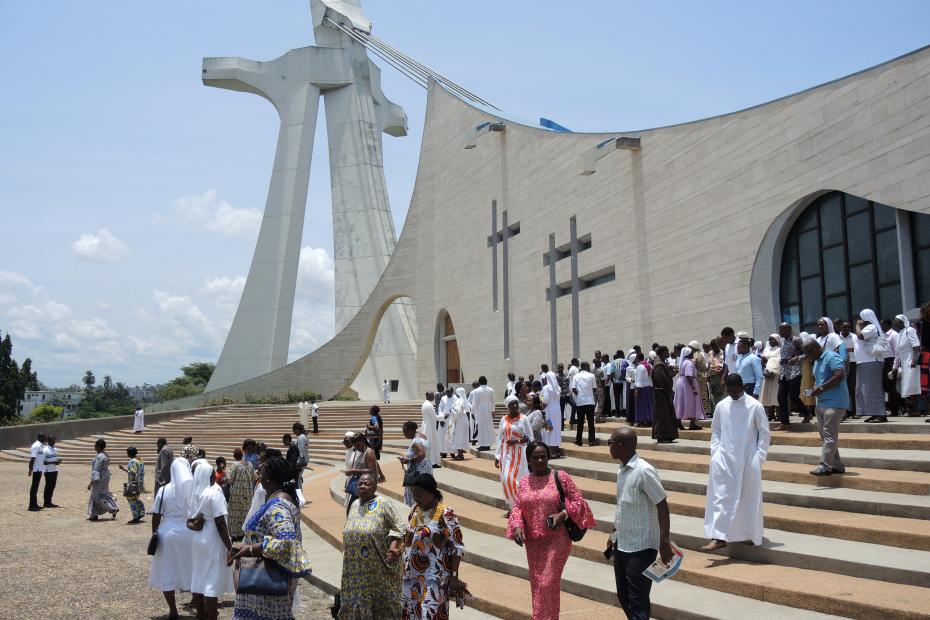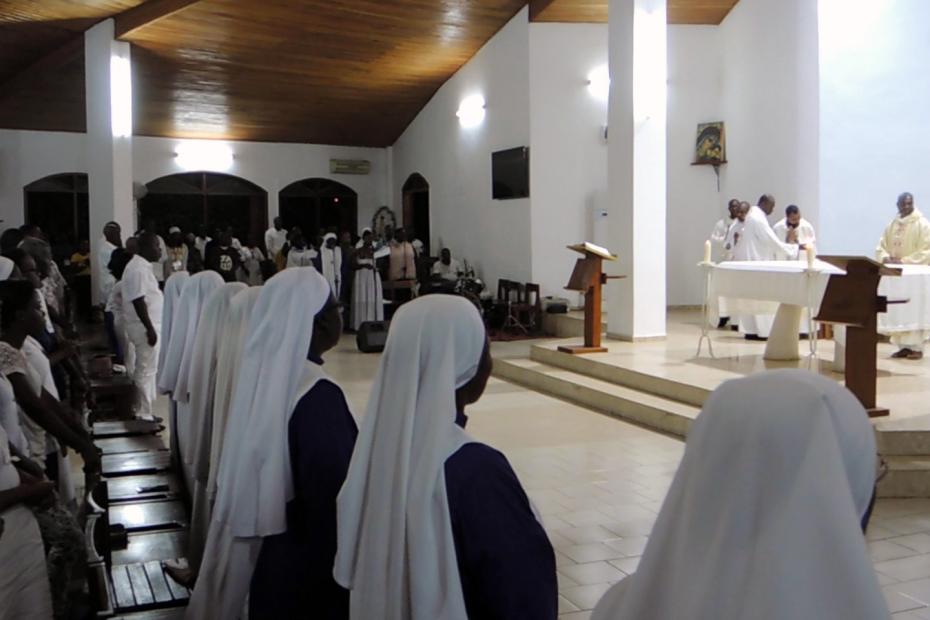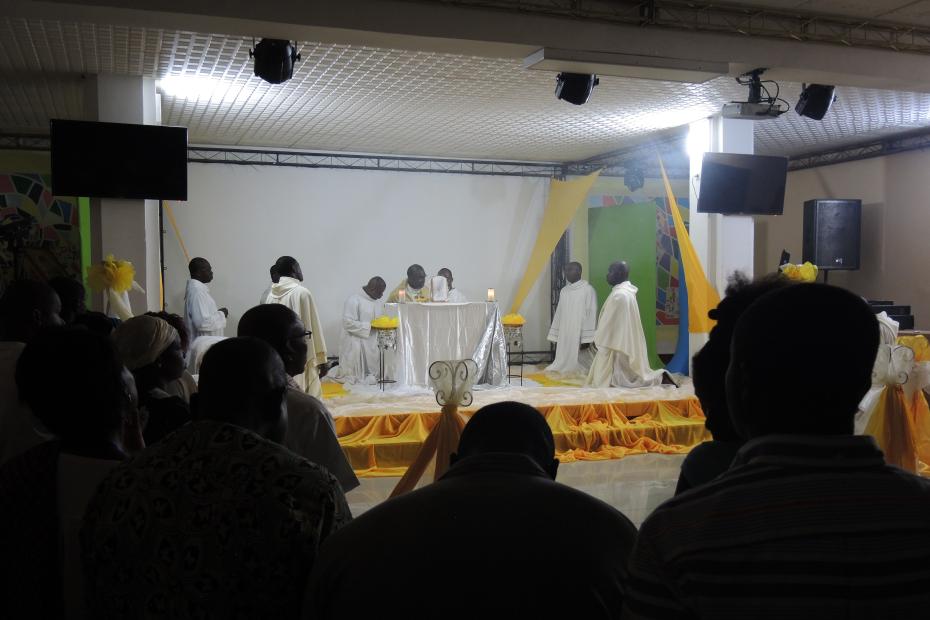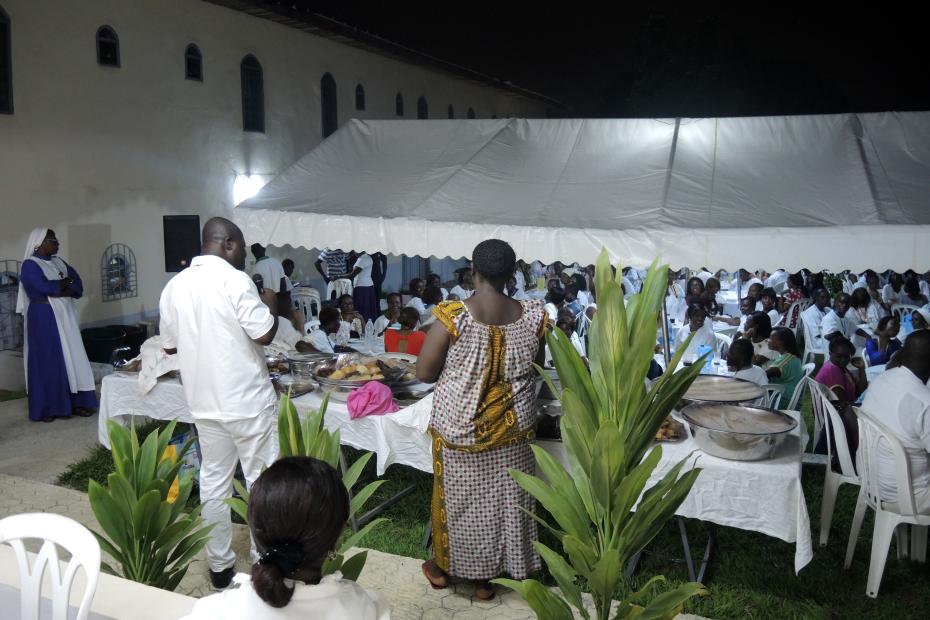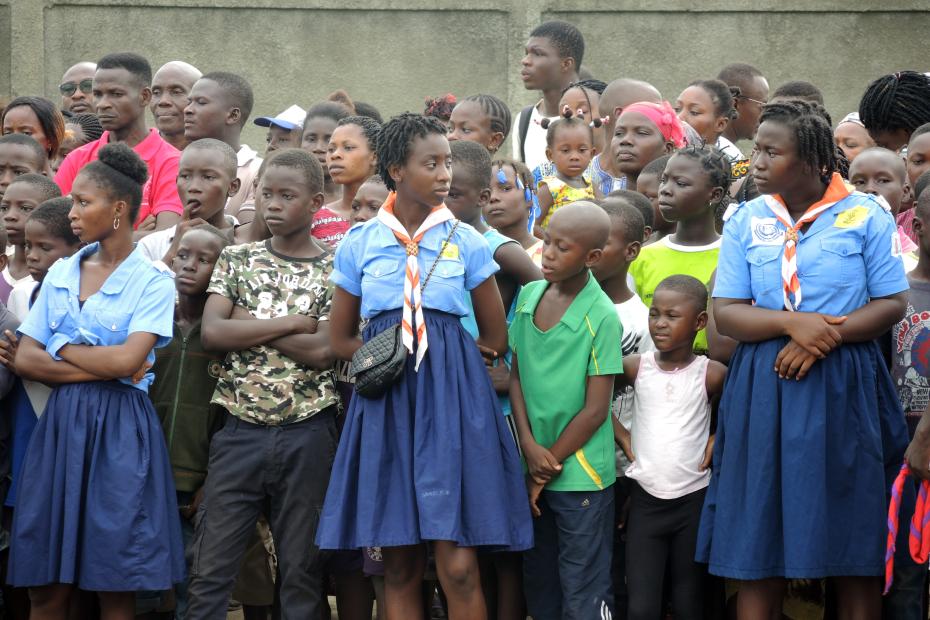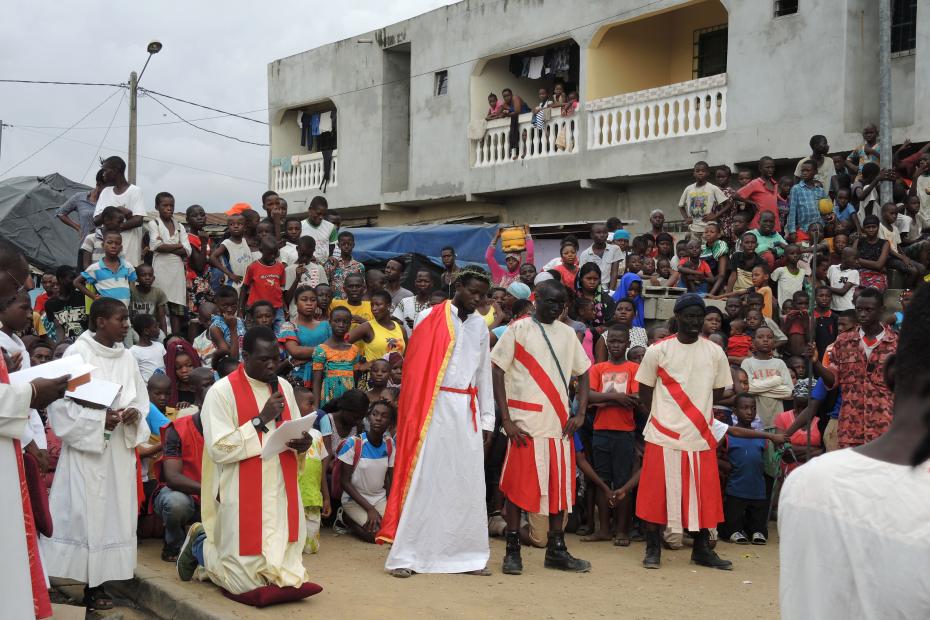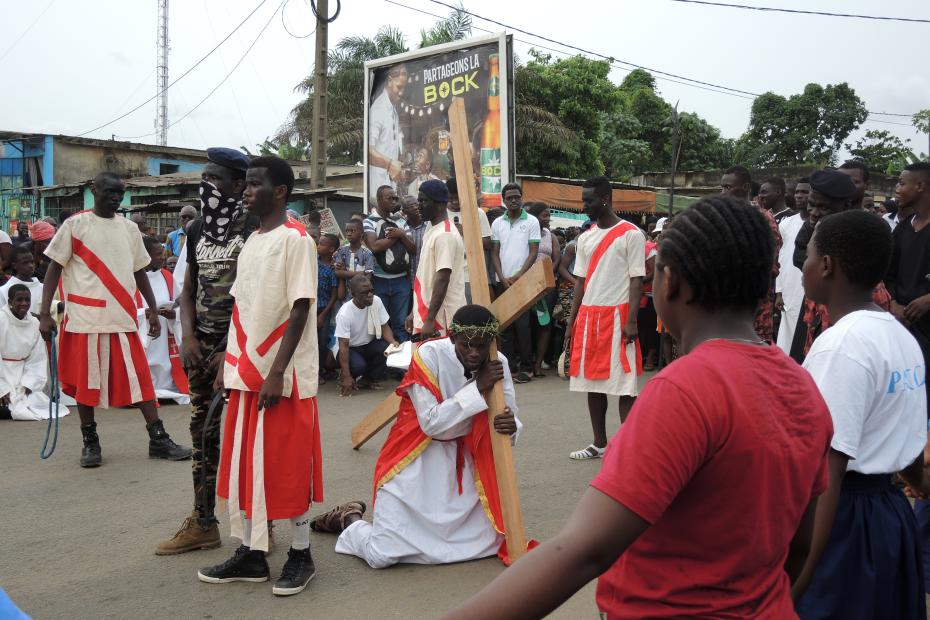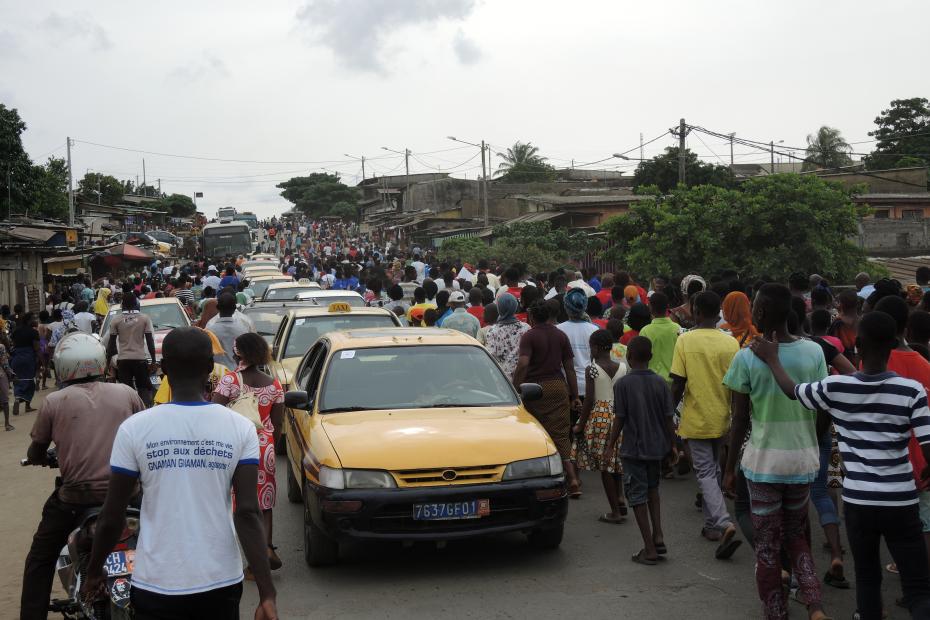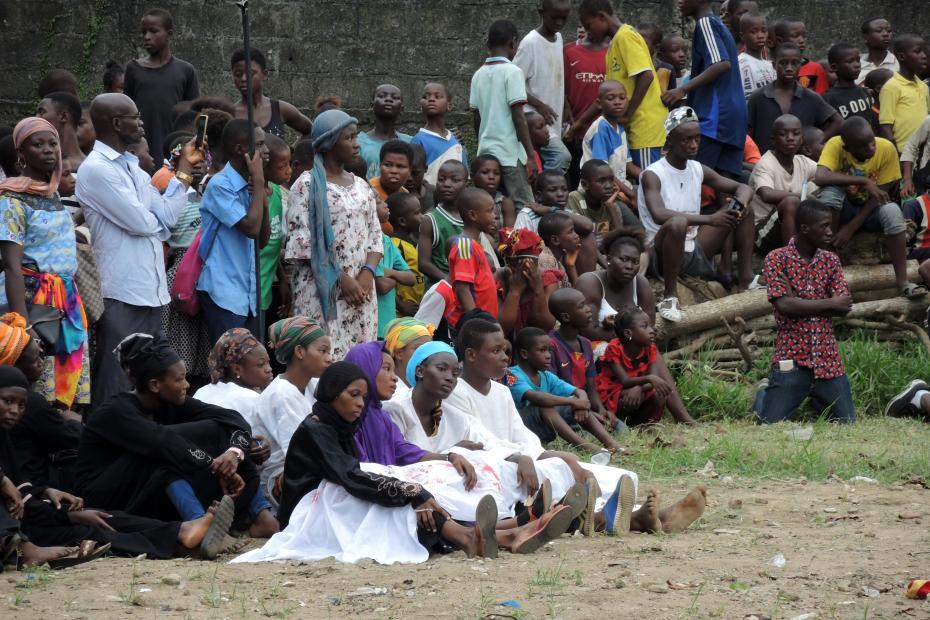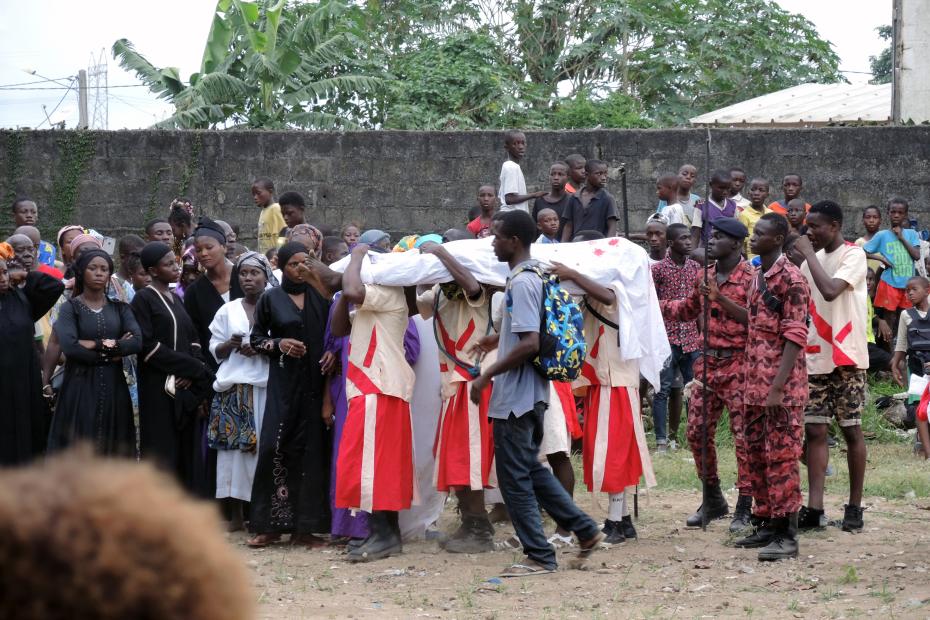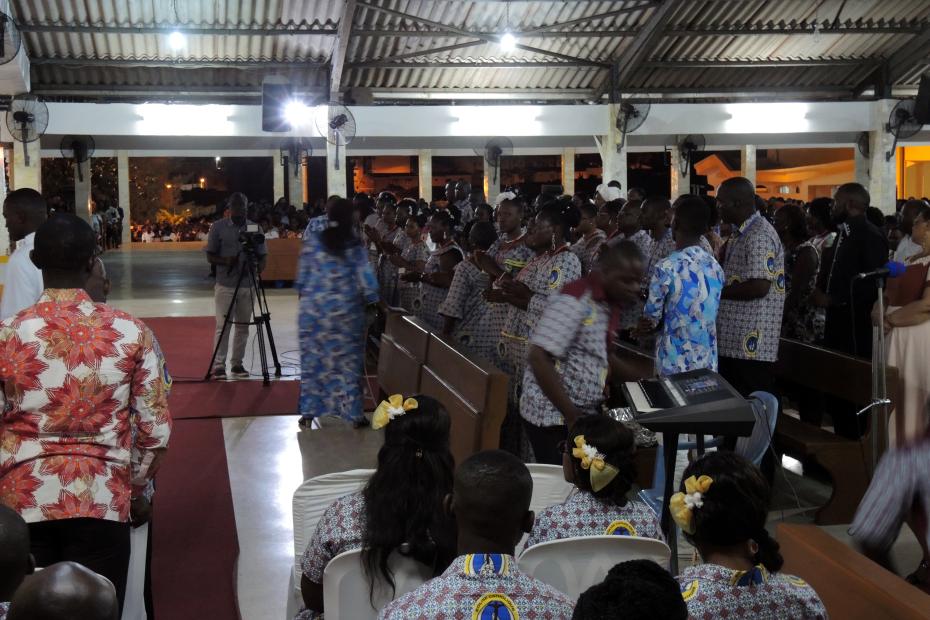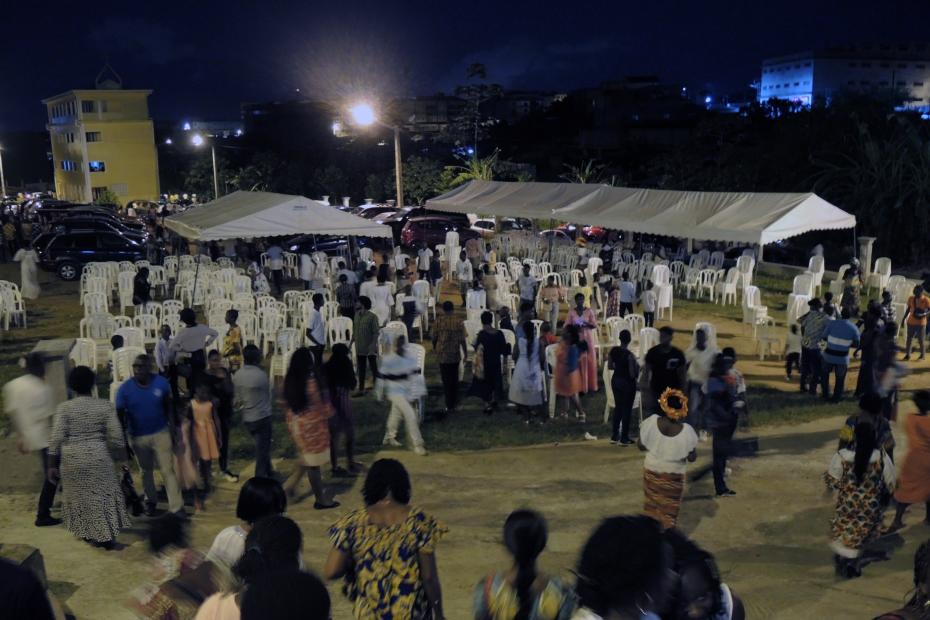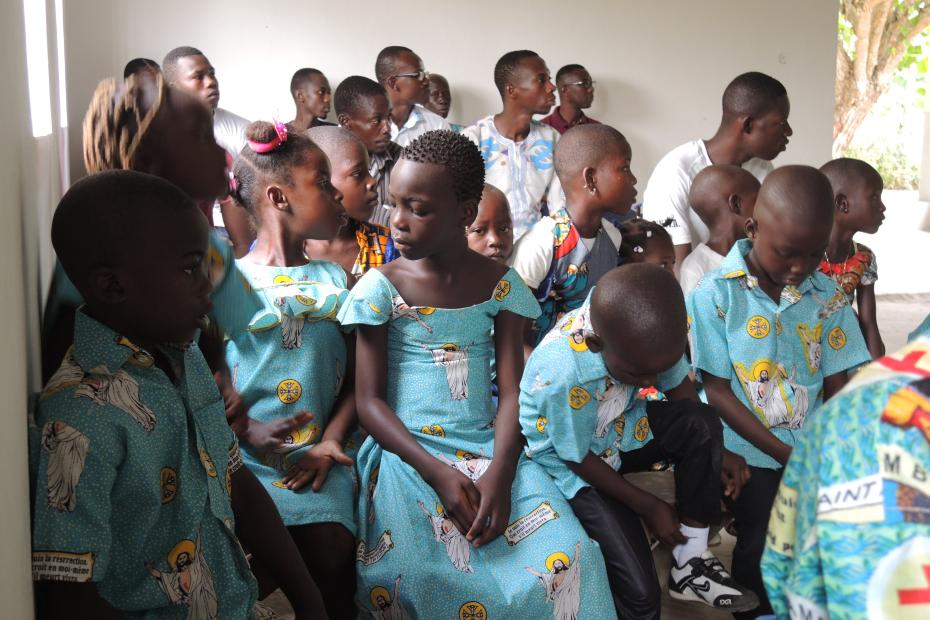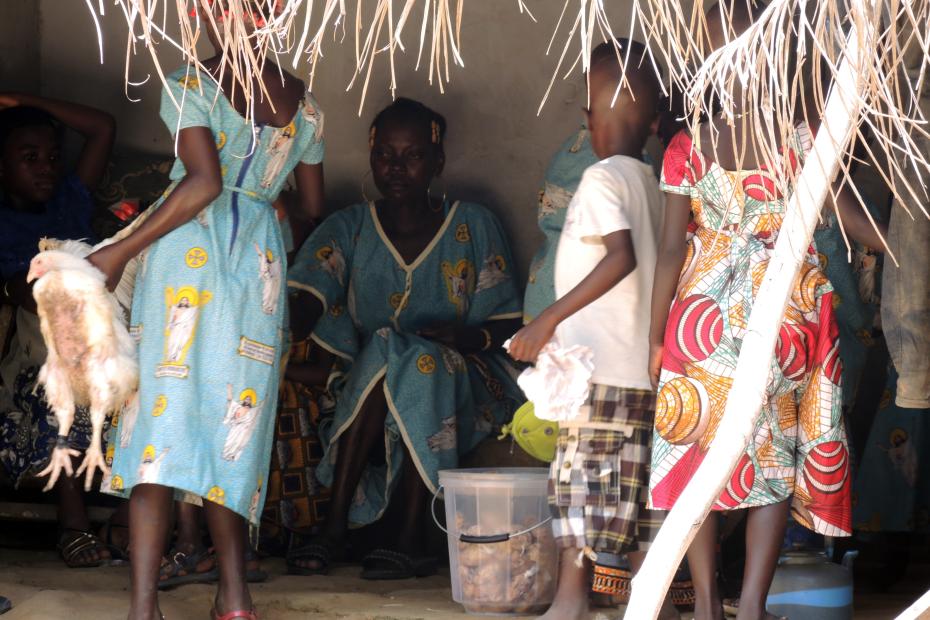Any attempt to convey Catholic life in a particular country comes up against the variety of contexts present there. In cosmopolitan Abidjan, home to people from at least 70 indigenous cultures, the influence of those cultures is harder to grasp and convey. The Church here is liturgically very Europeanized, even in its liturgical music and with French as the language of prayer.
Rather than choose one parish, the accounts below aim to capture the Holy Week experience in a number of contexts in Abidjan, from very poor to middle class. Holy Week recalls a wide range of emotional experiences, from the jubilation of Palm Sunday to the pain and violence of Good Friday and the hopefulness of new life at Easter, but even so, parishes in their different contexts celebrate them in different ways.
Celebrating Palm Sunday with great jubilation
Palm Sunday at St. Ambroise du Jubilé, Abidjan
Palm Sunday at St. Ambroise du Jubilé, a large church in Abidjan founded in 2008, ushers in Holy Week in a manner that shows the jubilant side of Ivoirien culture. Parishioners gather at various meeting points in the surrounding neighborhood to walk a kilometer or more to the church. Following a blessing of palms at each starting point, they march to brass accompaniment, many taking dance steps in the process through mostly quiet streets to the church. As group after group enters the church, the joy reaches a crescendo. The crowd fills out into the churchyard and eventually out the property gates. The Palm Sunday liturgy, which could not be videoed, is more restrained, but after the Mass, parishioners move outdoors to wave palms joyfully as they imagine that those who once saw Jesus entering Jerusalem did.
On Holy Tuesday, Abidjan’s elegant, modernist Cathedral of St. Paul is packed for the diocesan Chrism Mass, when clergy and other representatives of the diocese gather for a liturgy to bless the oils that are used sacramentally at baptism, confirmation, the sacrament of the sick and ordinations throughout the year.
Holy Thursday: Joining a communauté nouvelle at prayer
Communautés nouvelles—lay-led Catholic communities that grew out of the Catholic Charismatic Renewal movement in the Church—are arguably the biggest development in the Church of Côte d’Ivoire in the last several decades. They outnumber parishes in Abidjan, and are expanding to elsewhere in the Cote d’Ivoire and internationally.1
Many of the more than 1,700 members of the Communauté Mère du Divin Amour, the Community Mother of Divine Love, gather for Holy Thursday on the community’s main campus in Abidjan. The Communauté Mère du Divin Amour is the oldest of the communautés nouvelles, and one of the most influential. Though it is overwhelmingly composed of lay men and women, and led by the married layman who is its founder, the community has grown to include an order of 100 religious sisters, a group of consecrated lay Catholic women, and a diocesan-right order of priests.
After the lay members finish their jobs and family responsibilities, many gather on the campus for the Holy Thursday liturgy in the evening with the priests and sisters who live there.
Holy Thursday at Communauté Mère du Divin Amour, Abidjan, Côte d'Ivoire
The style of worship in different communautés nouvelles varies considerably—some are much more Pentecostal—but on Holy Thursday this charismatic community’s worship is more traditionally devotional and somber. Following Mass, the Eucharist is brought, with the community in procession behind it, to an auditorium with a decorated altar of repose. The community gathers afterward for a shared dinner outside under tents. Following dinner, members of the community read and act out the Passion and sing hymns. Finally, in the dark of the night, many in the crowd return to the altar of repose for silent prayer and adoration.
Good Friday: Le Chemin de Croix, the Way of the Cross, through Abobo-Sagbé
The Sagbé neighborhood of Abobo is home to a large Muslim community that has migrated from the north of Côte d’Ivoire and from neighboring countries. It is one of the poorest and most densely populated areas of Abidjan, having sprung up since the 1960s largely through squatting. 2
The neighborhood endured the violence of war when it was a site of a battle during the 2011 civil war. Perhaps from this experience, the parishioners of St. Philippe Church who organize the Chemin de Croix, or Way of the Cross, do not see any reason to gloss over the violence of the Passion story that they depict. Parishioners act out the roles along the route, accompanied by a growing crowd that follows the story. The violence of the scenes, according to parishioners, is an honest depiction: one young man simply said that it is structured “to be very precise,” not to add or subtract from the story.
St. Philippe has a decent-sized property that could have allowed them to host the Way of the Cross within the parish walls. Instead, it passes 1.7 km through the streets. Traffic on a local main road is forced to halt, at least for a short time. Bringing the Passion out into the streets, into the context of people’s daily lives, is not unusual in Abidjan, but it also reflects the broader philosophy of the parish. Parishioners there are conscious of the role that they have in the community, both to look out for others’ needs—food, clothing and school fees—through the parish’s tiny Caritas office, and to share the Gospel.
Way of the Cross, Good Friday, St. Philippe Parish, Abidjan, Côte d'Ivoire
Beyond its location on their streets, instead of on a stage designed only to evoke Jerusalem, two adaptations seem contemporarily evocative: having the crowd that yells “Crucify him” wear modern-day Ivoirien clothes and—in a country with fresh memories of two civil wars in the prior 20 years—having many of the soldiers in a blood-red version of modern military camouflage, wearing a customary beret of local forces.
The Muslim majority context in Abobo-Sagbé is much more reflective of the demographic status of Catholicism in the country as a whole than in Abidjan or the rest of the coastland. Muslims and Christians have been on opposing sides of political battles in recent decades, though there are significant efforts at interfaith outreach and harmony, particularly after the civil wars built on those tensions. While Catholic children would be expected to be respectful, knowing something of the meaning of the story (and would stand out from other children for being careful to wear clean clothes for the occasion), the presence of a larger crowd who were not religiously invested in the story, for whom it does not make religious sense, often means that the portrayal is even more like the original events might well have been: the crowd contains both people who see its story as a tragedy, and people who are amused by the violence of it.
In a context where all the painted and sculpted images of Jesus and Mary in churches, shrines and homes are white and European—even the abstract, modernist ones are preternaturally white—it is especially powerful—subversive yet perfectly orthodox—to see a black Jesus on the cross, a local Ivoirien vividly embodying the person of Jesus.
The Chemin de Croix at St. Philippe should not be taken as a typical experience in Côte d’Ivoire. Another parish, St. Ambroise Ma Vigne, more middle class and not that far away, organizes its Way of the Cross in a more restrained, ritualized—certainly less visceral—way.
Easter Vigil: Welcoming the newly baptized
At St. Jean-Paul II parish, in the neighborhood of Angré, the broad, open air church is filled to capacity, and chairs and giant television screens are set up outside for those who had not arrived at least one hour in advance. The center rows of the church, much of the way back, are reserved for adult catechumens and their sponsors. Thirty-two adults are baptized that night, four married, and many more confirmed. Those numbers are not unusual. The smaller St. Philippe parish, shown here on Good Friday, had 24 baptisms that night, and people there claim that a larger parish not far away would have hundreds baptized the same night. At St. Jean-Paul II, the newly-baptized wear specially-made dresses and shirts in a colorful fabric designed for the Church of Côte d’Ivoire.
Quality choral singing is a highly valued part of prayer in Côte d’Ivoire, and the choir here demonstrates its skill, leading the community both in traditional European forms of hymnody, and occasionally in more contemporary ones. Likewise, the celebration mixes solemnity at core ritual moments of the liturgy with celebration at the joy of the resurrection and the occasion of these new baptisms.
Easter Sunday: Il est vraiment ressuscité, He is truly risen!
Easter provides an opportunity to step out of Abidjan, to a village that is not physically very far away, but offers a very different context. Someday it is even foreseeable that growing Abidjan will encroach on tiny Bahouakoi, which recently built a small chapel and still has no resident priest. Some people in this town work in Abidjan and return when they can, but it is largely agricultural. The church is led by an older catechist, who is himself a first generation Catholic, having been baptized as a boy.
The people in the village live fairly subsistence-level lives, but Easter is a very special occasion, and the Catholics there mark it accordingly. Most notably, perhaps, many go out of their way to show what the occasion means by sewing clothes special for the day, on bright aqua fabric with images of the resurrected Christ. Even those who don’t have Easter clothes are dressed in their best. The music is lively, not as elegant as some of the music sung in larger churches and cathedrals, but sung with care. The congregation applauds when they and the priest announce, Il est vraiment ressuscité, Alleluia!—He is truly risen, Alleluia! After Mass, they are diligent to introduce and welcome a number of visitors and Easter returnees, and after gathering around the church, enjoy Easter chicken and stews.
Easter Sunday in Bahouakoi, outside Abidjan, Côte d'Ivoire
To Galilee on Easter Monday
Easter Monday is also a time of celebration known in Côte d’Ivoire as “Galilée,” the feast of Galilee. The name derives from the references to Galilee in Matthew 28:1-10, when after the resurrection the angel told the women at the tomb, “go quickly and tell his disciples, ‘He has been raised from the dead, and he is going before you to Galilee; there you will see him.’” Jesus met the women along the way and said to them, “Do not be afraid. Go tell my brothers to go to Galilee, and there they will see me.”3
Families gather at parishes or some other locale for Mass and large celebratory meals, and even for dancing and entertainments.
- 1 The COVID-19 crisis deferred a large conference that Catholics & Cultures expected to co-sponsor in Abidjan on the communautés nouvelles, delaying our plans to present a fuller view of the communities on this site. Look for more in the future.
- 2For an account of the economic and political situation in Abobo, see Yacouba Konaté, “Abobo, ADOland d’hier et d’aujourd’hui,” Afrique Contemporaine 263-264, no. 3 (2017): 341-364, accessible online and in English as “Abobo, ADOland of the past and present (Abidjan, Côte d’Ivoire).”
- 3 New American Bible, Revised Edition.
